Text
Audre Lorde

From 1977 to 1978, Lorde had a brief affair with the sculptor and painter Mildred Thompson. The two met in Nigeria in 1977 at the Second World Black and African Festival of Arts and Culture (FESTAC 77). Their affair ran its course during the time that Thompson lived in Washington, D.C.[74]
During her time in Mississippi in 1968, she met Frances Clayton, a white lesbian and professor of psychology who was to be her romantic partner until 1989. Their relationship continued for the remainder of Lorde's life.[74]
Lorde and her life partner, black feminist Dr. Gloria I. Joseph, resided together on Joseph's native land of St. Croix. Together they founded several organizations such as the Che Lumumba School for Truth, Women's Coalition of St. Croix, U.S. Virgin Islands, Sisterhood in Support of Sisters in South Africa, and Doc Loc Apiary.[75]
from wikipedia.
0 notes
Text
Lorraine Hansberry

Hansberry was a closeted lesbian.[4][5][6] Before her marriage, she had written in her personal notebooks about her attraction to women.[4][26] In 1957, around the time she separated from Nemiroff, Hansberry contacted the Daughters of Bilitis, the San Francisco-based lesbian rights organization, contributing two letters to their magazine, The Ladder, both of which were published under her initials, "LHN."[27] Pointing to these letters as evidence, some gay and lesbian writers credited Hansberry as having been involved in the homophile movement or as having been an activist for gay rights.[28][29] According to Kevin J. Mumford, however, beyond reading homophile magazines and corresponding with their creators, "no evidence has surfaced" to support claims that Hansberry was directly involved in the movement for gay and lesbian civil equality.[30][31]
Mumford stated that Hansberry's lesbianism caused her to feel isolated while A Raisin in the Sun catapulted her to fame; still, while "her impulse to cover evidence of her lesbian desires sprang from other anxieties of respectability and conventions of marriage, Hansberry was well on her way to coming out."[32] Near the end of her life, she declared herself "committed [to] this homosexuality thing" and vowing to "create my life—not just accept it".[24] Before her death, she built a circle of gay and lesbian friends, took several lovers, vacationed in Provincetown (where she enjoyed, in her words, "a gathering of the clan"),[33] and subscribed to several homophile magazines.[33]
from wikipedia.
0 notes
Text
Dorothy Bussy

Dorothy was bisexual and was involved in an affair with Lady Ottoline Morrell.
Bussy anonymously published one novel, Olivia, in 1949, printed by the Hogarth Press, the publishing house founded by Leonard and Virginia Woolf, in which lesbian loves get entangled in the emotional and sexually charged atmosphere of erotic pedagogy in a girls' school. As well as drawing on her own experiences in the schools of Marie Souvestre, the novel's theme probably owes much to Bussy's viewing of the 1931 German film Mädchen in Uniform, that had been distributed in England before the Second World War.
from wikipedia.
1 note
·
View note
Text
Marie Souvestre
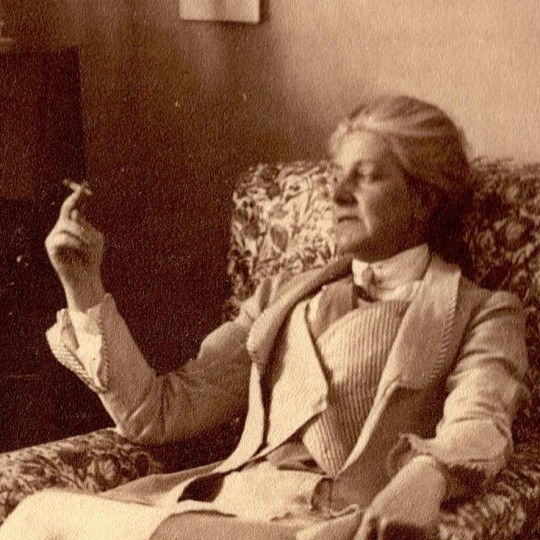
Marie Souvestre (28 April 1830 – 30 March 1905) was an educator who sought to develop independent minds in young women.[1] She founded a school in France and when she left the school with one of her teachers she founded Allenswood Academy in London.
She was born in Brest, France, the daughter of French novelist Émile Souvestre. She founded the girls' boarding schools Les Ruches ("the beehives") in Fontainebleau, France, where writer Natalie Clifford Barney and her sister Laura Clifford Barney were later educated, and Allenswood Boarding Academy, in Wimbledon, outside London, where her most famous pupil was Eleanor Roosevelt.[2]
Dorothy Bussy, the sister of writer Lytton Strachey, anonymously published a novel, Olivia (1949), about her experience as a pupil at Les Ruches, describing the protagonist's crush on the headmistress Mlle. Julie (i.e., Souvestre).
Souvestre has been described as a lesbian.[5] She founded Les Ruches with her partner Caroline Dussaut. Dussaut is Cara in Bussy's novel, Olivia.[6] When they separated in 1883, Souvestre moved to England with Paolina Samaïa, former teacher at Les Ruches who would become a teacher at Allenswood Academy as well as Souvestre's long-term partner.[7][8]
from wikipedia. souvestre was also connected with three other wlw who are also featured here (roosevelt, barney and bussy)! :) all this because i looked up olivia (1951) after seeing a gifset, which led me to dorothy bussy, which led me to s.
0 notes
Text
Eileen Gray
from wikipedia.

Eileen Gray (born Kathleen Eileen Moray Smith; 9 August 1878 – 31 October 1976) was an Irish architect and furniture designer and a pioneer of the Modern Movement in architecture. Over her career, she was associated with many notable European artists of her era, including Kathleen Scott, Adrienne Gorska, Le Corbusier, and Jean Badovici, with whom she was romantically involved. Her most famous work is the house known as E-1027 in Roquebrune-Cap-Martin, France.
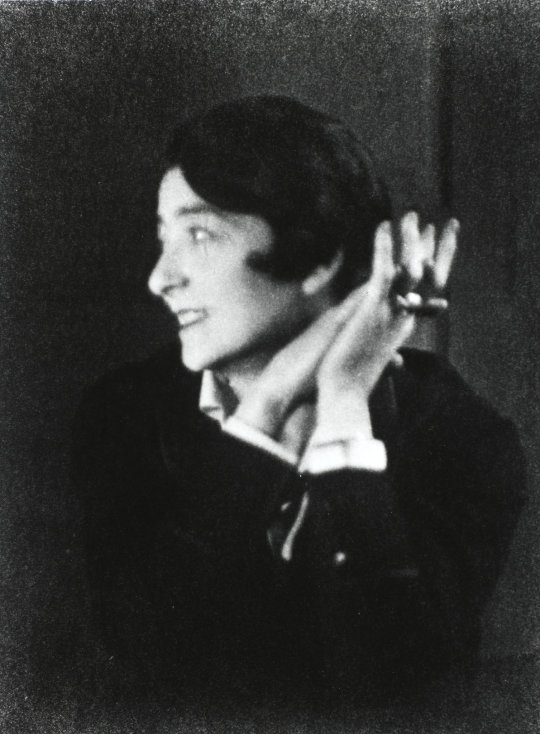
Gray was bisexual. She mixed in the lesbian circles of the time, being associated with Romaine Brooks, Loie Fuller, Marie-Louise Damien, and Natalie Barney.[20]
Gray's intermittent relationship with the singer Damia ended in 1938, after which they never saw each other again, although both lived into their nineties in the same city. Gray also had for some time an intermittent relationship with Jean Badovici, the Romanian architect and writer.[4]
0 notes
Text
Christa Winsloe
from wikipedia. i think i found winslow after seeing pictures of mädchen in uniform: it was weird seeing lesbian content from 1930s germany! i thought somebody involved must have been gay themselves, so it was nice to find christa :)
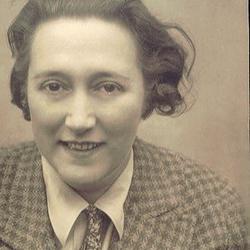
She was born in Darmstadt. After her mother's early death, she was sent to the Kaiserin-Augusta-Stift, a very strict boarding school in Potsdam. In this institution, the girls of the aristocracy were drilled to learn discipline and submission. After leaving school, she married Baron Ludwig Hatvany (1880–1961), a rich Hungarian writer and landowner.
While married to Hatvany, Winsloe wrote Das Mädchen Manuela ("The Child Manuela"), a short novel based on her experiences at Kaiserin-Augusta. Soon after, her marriage broke up, but Hatvany made her a generous allowance after their divorce. That novel was released in 1933.
Winsloe was involved in a relationship with newspaper reporter Dorothy Thompson, probably before World War II when Thompson was reporting from Berlin.[1]
In 1932, her play was performed as "Children in Uniform" (English adaptation by Barbara Burnham) at the Duchess Theatre in London with Cathleen Nesbitt and Jessica Tandy in the cast.
The play's success led to the production of the film Mädchen in Uniform (1931); Winsloe was one of the screenwriters. Mädchen in Uniform was a considerable success, both financially and critically. This was due to its ambitiously aesthetic form and the fact that only women performed in it. The lesbian aspect of the story was downplayed and depicted as an adolescent crush, even though Winsloe co-authored the script, and Leontine Sagan, who in the play had stressed the lesbian aspect, acted as director.
The play ends differently from the film. In the play, the young student, Manuela, is destroyed because of rejection by her teacher, Fräulein Elizabeth von Bernburg, who did not dare to side with Manuela against the headmistress or oppose the brutal educational methods. Manuela commits suicide. The film is more ambiguous, with von Bernburg attempting to defend the student and herself. Christa Winsloe may be recorded as having written the first detailed play on lesbianism in the Weimar Republic.
On the strength of the play's acclaim, Winsloe moved to Berlin, where there was a lesbian sub-culture. She had plenty of money (from her ex-husband's allowance), worked as an animal sculptor, and had a wide circle of friends. She was a member of the SPD (the German Social Democrats, then largely reform Marxist in orientation), and was open about her sexuality.
She moved to France in the late 1930s, fleeing the Nazis. During World War II, she joined the French Resistance. Contrary to what is often stated, she was not executed by the Nazis. Instead, on 10 June 1944, Winsloe and her French partner, Simone Gentet, were shot and killed by four Frenchmen in a forest near the country town of Cluny. The exact reason why she and Gentet were killed was never fully clarified, but presumably they were falsely suspected to be Nazi spies by the Frenchmen.[3]
1 note
·
View note
Text
in my search for other sapphic indian women, i found two:
Suniti Namjoshi
i looked long and hard for more about her life in the 80s, as mentioned here:
The 1980s were owned by Suniti Namjoshi, an openly lesbian author of Indian origin. She wrote books like Feminist Fables (1981), From the Bedside Book of Nightmares (1984), The Conversations of Cow (1985), Flesh and Paper (1986) and The Mothers of Maya Diip (1989), among others, exploring various aspects of the feminine, especially sexuality.
source ^
but there’s barely anything. gayness in india, especially the sapphic kind, feels minimally documented. there aren’t any long, detailed wikipedia pages for indian sapphics :(

more, from here:
Born in Mumbai in 1941, Suniti Namjoshi went to school at American mission school in the Himalayan foothills and eventually served as an officer in the Indian Administrative Services before relocating to the U.S. for college. Namjoshi earned her Master’s degree in Public Administration from the University of Missouri and a Ph.D. from McGill University where she studied Ezra Pound. She then became a teacher, lecturing in the Department of English at the University of Toronto in the 1970s and ’80s while also beginning to publish some of her groundbreaking women-focused works.
She left the University of Toronto in 1987 to write full-time and became active in Canada’s women-focused and LGBTQ political movements, inspired in part by Kate Millett‘s “Sexual Politics” as well as “the work of writers like Virginia Woolf and Adrienne Rich.” The majority of her work has been not only inclusive of but focused on the intersectional parts of her identity, especially her being a lesbian and a feminist.
also notable: this from queerink and this

from flesh and paper (1987), with gillian hanscombe:
All right, call them another species, throw off nouns with a categorical
clink.
A tiger, a woman and a man are different. A lesbian is the fourth. A
man says, ‘Only I am human.’ His woman says, 'Yes, but I am human
too. Perhaps not quite as human as him or you, but very human too.’
There is no difficulty. But the lesbian and the tiger do not speak — not to
the man. In his kingdom they’re a threatened species. They speak to the
woman. She listens for a while, is charmed and enthralled, but then
they’re overheard. She runs to her man. 'Serpents,’ she hisses. She spits
and she cries. 'You’ve got it all wrong,’ the lesbian mutters, the tiger is
pleading. But in the patriarchal skies there’s death and destruction. They
retreat to the forest and discuss logic.
If you agree not to play pedant, I’ll agree not to play poet. So we can
begin in the middle.
Tigers, women, men and lesbians are all different, you say.
Sure. But a masquerade is sometimes in order — we need the relief —
and a reconnaissance mission is never out of order if one’s bent on
survival.
Look at it this way. Tigers prey anyhow, given no other option.
Whether it’s their nature or not, who can say? But it’s clear their
digestive tract dictates it. As for women — well — better to be eaten than
to eat: it’s a question of morality after all. And men, being more interested
in muscle than morality (there’s a principle at stake) take what they
can get: tigers, women… each has its purpose.
But lesbians. Now. There’s phenomenon. The digestive tract has no
special distinction. Some parts of the musculature are more developed
than we might have expected; but taken overall both muscle and morality
leave them disinterested. Tigers they admire; men they find puzzling,
but hardly relevant; and women they merely desire.
So which of the four is most human?
Tigers, no doubt you’ll say, finding no fault with the dictates of the
flesh.
Still, I must argue, it takes a lesbian to see it how it is.
'It Takes a Lesbian’ is Section 3 of Flesh and Paper which will be published by GMP Publishers in November 1986.
source ^
now for the second:
Amrita Sher-Gil
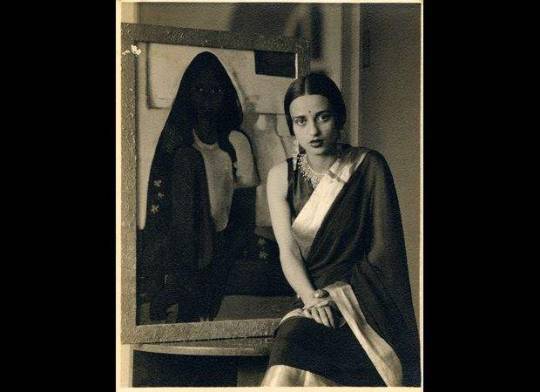


again, her wikipedia page makes no mention of her gayness, so we look in other places instead. from here:
Born in Budapest in 1913 to a Jewish mother and an Indian father, Amrita Sher-Gil was their first of two children whom they raised in luxury. From a young age, Amrita was rebellious, getting herself kicked out of a convent school by declaring herself an atheist. With the support of her family, she found her passion, starting with portraits of her servants. It wasn’t long before she was enrolled in art lessons, and she later used those connections to secure herself a spot at Santa Annunziata in Florence.
It is hard to say now if Amrita Sher-Gil would be pleased with her legacy. She is one of the most well known Indian women in art. However, it is also known that her mother burned her early letters describing her relationships with women. When she learned this, she was horrified. Fortunately, the burning of these documents has not completely erased her identity. In fact, most sources discuss her bisexuality openly. Considering her multiple relationships with women throughout her life, it is hard to ignore.
there’s a post on classiclesbians too (a great supplement to otherwise finding sapphics in the wild):
Amrita was a popular Indian painter sometimes referred to as “India’s Frida Khalo.” Born in Budapest, Hungary on the 30th of January 1913, she was raised by her Punjabi Sikh father and Hungarian-Jewish mother. This parentage offered an identity struggle throughout the artist’s life. Caught between Western and Indian origins, Amrita donned her sari on some days; but on other occasions, she leaned more towards Western fashion. At the age of sixteen, Amrita moved to Paris to study at the École de Beaux-Arts. It was here that her father reported she had multiple affairs with both men and women. Her explanation was, “How can one feel the beauty of a form, the intensity or the subtlety of a color, the quality of a line, unless she is a sensualist of the eyes?” Once she and her family moved to India, her affairs with women grew to be well-known. Unfortunately, many of her intimate letters were burned by her usually liberal parents because of this. Her paintings, not unlike those of Khalo, challenged the views of the public on the sexuality and expectations of women. Her paintings of daily life in India are some of the most popular and realistic. Amrita Sher-Gil died at the age of 28 after hemorrhaging from an unsuccessful abortion, leaving her legacy behind in an abundance of paintings.
0 notes
Text
Natalie Barney
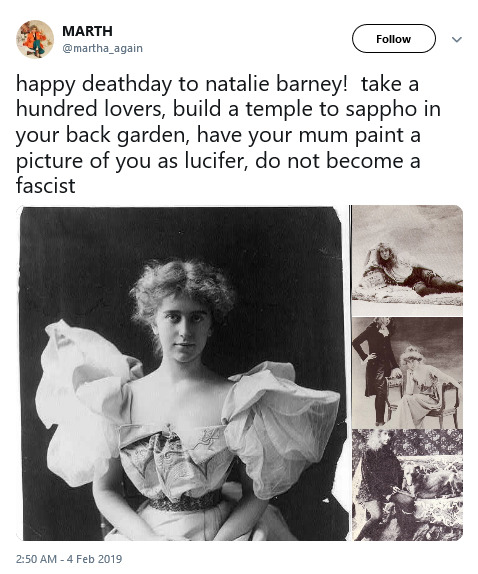
a twitter thread and her wikipedia page. there’s a whole section dedicated to major relationships!
Barney later said she knew by age 12 she was lesbian[17] and was determined to "live openly, without hiding anything."[18] In 1899, after seeing the courtesan Liane de Pougy at a dance hall in Paris, Barney presented herself at de Pougy's residence in a page costume and announced she was a "page of love" sent by Sappho.
Although de Pougy was one of the most famous women in France, constantly sought after by wealthy and titled men, Barney's audacity charmed her. Their brief affair became the subject of de Pougy's tell-all roman à clef, Idylle Saphique (Sapphic Idyll). Published in 1901, this book became the talk of Paris, reprinted at least 69 times in its first year. Barney was soon well known as the model for one of the characters. By this time, however, the two had already broken up after quarreling repeatedly over Barney's desire to "rescue" de Pougy from her life as a courtesan.[19]
Barney herself contributed a chapter to Idylle Saphique in which she described reclining at de Pougy's feet in a screened box at the theater, watching Sarah Bernhardt's play Hamlet.[20] During intermission, Barney (as "Flossie") compares Hamlet's plight with that of women: "What is there for women who feel the passion for action when pitiless Destiny holds them in chains? Destiny made us women at a time when the law of men is the only law that is recognized."[21] She also wrote Lettres à une Connue (Letters to a Woman I Have Known), her own epistolary novel about the affair. Although Barney failed to find a publisher for the book and later called it naïve and clumsy, it is notable for its discussion of homosexuality, which Barney regarded as natural and compared to albinism.[22] "My queerness," she said, "is not a vice, is not deliberate, and harms no one."[23]
Barney's earliest intimate relationship was with Eva Palmer-Sikelianos. In 1893 they became acquainted during summer vacations in Bar Harbor, Maine. Barney likened Palmer to a medieval virgin, an ode to her ankle length red hair, sea-green eyes and pale complexion.[24] The two remained close for a number of years. As young adults in Paris they shared an apartment at 4, rue Chalgrin. Later they each had their own place in Neuilly.[25] Barney frequently solicited Palmer's help in her romantic pursuits of other women, such as Pauline Tarn.[26] Palmer ultimately left Barney's side for Greece and eventually married Angelos Sikelianos. Their relationship did not survive this turn of events, Barney took a dim view of Angelos and heated letters were exchanged.[27] Later in their lives the friendship was repaired and both took a mature view on the roles they had played in each other's lives.[28]
In November 1899 Barney met the poet Pauline Tarn, better known by her pen name Renée Vivien. For Vivien it was love at first sight, while Barney became fascinated with Vivien after hearing her recite one of her poems,[29] which she described as "haunted by the desire for death."[30] Their romantic relationship was also a creative exchange that inspired both of them to write. Barney provided a feminist theoretical framework which Vivien explored in her poetry. They adapted the imagery of the Symbolist poets along with the conventions of courtly love to describe love between women, also finding examples of heroic women in history and myth.[31]Sappho was an especially important influence and they studied Greek so as to read the surviving fragments of her poetry in the original. Both wrote plays about her life.[32]
0 notes
Photo
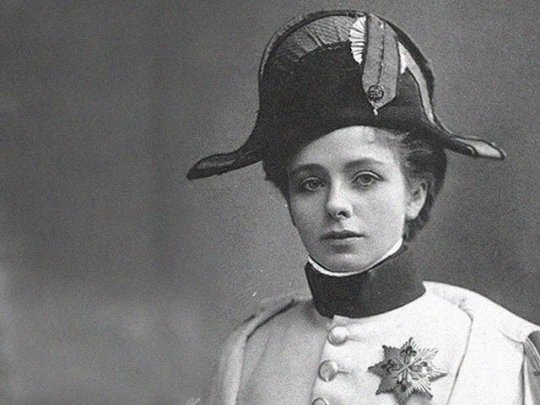

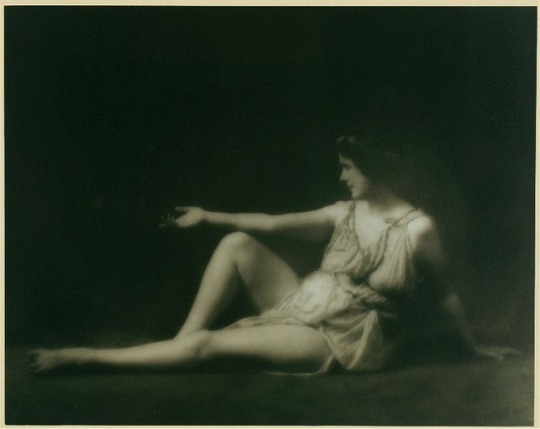







Mercedes de Acosta
Mercedes de Acosta (March 1, 1893 – May 9, 1968) was an American poet, playwright, and novelist. De Acosta wrote almost a dozen plays, only four of which were produced, and she published a novel and three volumes of poetry.[1] She was professionally unsuccessful but is known for her many lesbian relationships with famous Broadway and Hollywood personalities and numerous friendships with prominent artists of the period.[2][3]
She was described in 1955 by Garbo biographer, John Bainbridge, as "a woman of courtly manners, impeccable decorative taste and great personal elegance... a woman with a passionate and intense devotion to the art of living... and endowed with a high spirit, energy, eclectic curiosity and a varied interest in the arts."[8]
Personal life
De Acosta was involved in numerous lesbian relationships with Broadway's and Hollywood's elite and she did not attempt to hide her sexuality; her uncloseted existence was very rare and daring in her generation.[3] In 1916 she began an affair with actress Alla Nazimova and later with dancer Isadora Duncan. Shortly after marrying Abram Poole in 1920, de Acosta became involved in a five-year relationship with actress Eva Le Gallienne.[9] De Acosta wrote two plays for Le Gallienne, Sandro Botticelli and Jehanne de Arc. After the financial failures of both plays they ended their relationship.
Over the next decade she was involved with several famous actresses and dancers including Greta Garbo, Marlene Dietrich, Ona Munson, and Russian ballerina Tamara Platonovna Karsavina.[10] Additional unsubstantiated rumors include affairs with Pola Negri, Eleonora Duse, Katherine Cornell, and Alice B. Toklas.[10]
It has often been said that she once stated, "I can get any woman away from any man" but there is no evidence to substantiate this claim.[3]
An ardent liberal, de Acosta was committed to several political causes. Concerned about the Spanish Civil War, which began in 1936, for example, she supported the loyalist Republican government that opposed the fascist Franco regime.[11] A tireless advocate for women's rights, she wrote in her memoir, "I believed...in every form of independence for women and I was...an enrolled worker for women's suffrage."[11][12]
Relationship with Greta Garbo
De Acosta's best-known relationship was with Greta Garbo. When Garbo's close friend, author Salka Viertel, introduced them in 1931, they quickly became involved.[14] As their relationship developed, it became erratic and volatile with Garbo always in control.[15] The two were very close sporadically and then apart for lengthy periods when Garbo, annoyed by Mercedes' obsessive behavior, coupled with her own neuroses, ignored her.[16] In any case, they remained friends for thirty years during which time Garbo wrote de Acosta 181 letters, cards, and telegrams.[17][18] About their friendship, Cecil Beaton, who was close to both women, recorded in his 1958 memoir, "Mercedes is [Garbo's] very best friend and for 30 years has stood by her, willing to devote her life to her".[19]
Although it has been argued that an intimate relationship between them cannot be proved, de Acosta states they were lovers. Contrary to legend, she did not do so in her memoir. In 1959, when she was destitute, de Acosta sold her papers to the Rosenbach Museum & Library in Philadelphia and claims to have reluctantly included romantic letters from Garbo.[20] "I would not have had the heart or courage to have burned these letters", she wrote William McCarthy, curator of the museum. "I mean, of course, Eva [sic], Greta's and Marlene's who were lovers.... I only hope...they will be respected and protected from the eyes of vulgar people".[20] All of Garbo's and de Acosta's recent biographers, moreover, discuss their involvement.[21][22][2][3][23] Per de Acosta's request, Garbo's letters were made available to the public in 2000, ten years after her death, and none were explicitly romantic. It should be noted that Garbo's family, which controls her estate,[24] has permitted only 87 letters to be made public.[25]
Later life, controversial autobiography and death
In 1960, when de Acosta was seriously ill with a brain tumor and in need of money, she published her memoir, Here Lies the Heart. The book was well-received by the critics and many close friends praised the book.[32] But its implied homosexuality[33] resulted in the severance of several friendships with women who felt she had betrayed their sexuality. Garbo also ended their friendship at this time. Eva Le Gallienne in particular was furious, denouncing de Acosta as a liar and stating that she invented the stories for fame. This characterization is inaccurate since many of her affairs and relationships with women, including that with Le Gallienne, are confirmed in personal correspondence.[34] An exception to this was Marlene Dietrich, who continued to correspond with her and loved the book.[35] According to critic Patricia White, "If she craved being seen, MdA was more careful about what she said than she is given credit for. She wrote a name-dropping memoir, but for something attacked for exaggeration, it barely alludes to homosexuality".[36] In any case, she gained a reputation that was not appreciated by everyone. But as Alice B. Toklas, lover of Gertrude Stein and de Acosta's long-term friend, wrote to a disapproving critic, "Say what you will about Mercedes, she's had the most important women of the twentieth century".[10]
De Acosta died at age 75 in poverty. She is buried at Trinity Cemetery in Washington Heights, New York City.[37][38]
she’s like some sort of dyke god. and even more pictures, since the tumblr photo gallery limit cannot hold her powers:

that’s Alice B. Toklas

and that’s Katharine Cornell.
from wikipedia.
0 notes
Photo

Pat Parker
there aren’t many pictures of pat parker on the internet. i found her from for willyce:
When i make love to you
i try
with each stroke of my tongue
to say
i love you
to tease
i love you
to hammer
i love you
to melt
i love you
and your sounds drift down
oh god!
oh jesus!
and i think
here it is, some dude’s
getting credit for what
a woman
has done
again.
Pat Parker was born in Houston in 1944 and moved after high school to Los Angeles and San Francisco to become an artist.
She came to realize she was attracted to women after two marriages to male writers—the Black Panther minister of culture and playwright Ed Bullins and the poet and publisher Robert F. Parker. In the 1970s and 1980s, she gained her own prominence in the midst of the women’s rights movement. Her vibrant friendships with other well-known feminist poets make Parker’s papers resonate meaningfully with many parts of the Schlesinger’s collections.
Parker, who earned a living working at the Oakland Feminist Health Clinic, shared the majority of her adult life with Martha (Marty) Dunham, and together they raised a daughter. Parker traveled to Kenya and Ghana in 1985 with two separate United Nations delegations. Her travels in Nairobi and Accra made an important impression on her.
Domestic abuse became a theme for her after her first husband pushed her down a flight of stairs, leading to a miscarriage. Later, one of her four sisters was murdered by her ex-husband. Parker told this story in an astonishing long poem, “Womanslaughter.”
source: https://www.radcliffe.harvard.edu/news/schlesinger-newsletter/poet-and-activist-pat-parker
She left home at 17 and moved to Los Angeles, California, to attend college. She earned an undergraduate degree at Los Angeles City College and a graduate degree at San Francisco State College.[4] She married playwright Ed Bullins in 1962.[4][6] Parker and Bullins separated after four years. She later said that her ex-husband was physically violent and that she was "scared to death".[7] She married Robert F. Parker, writer and publisher,[4][8] but decided that the "idea of marriage... wasn't working" for her.[7] She began to identify as a lesbian in the late 1960s, and, in a 1975 interview with Anita Cornwell stated: "after my first relationship with a woman, I knew where I was going."[7]
Cheryl Clarke, another poet and peer, identifies her as a "lead voice and caller" in the world of lesbian poetry.[17] Designed to confront both black and women's communities with, as Clarke notes, "the precariousness of being non-white, non-male, non-heterosexual in a racist, misogynist, homophobic, imperial culture."[18] Clarke believes that Parker articulates, "a black lesbian-feminist perspective of love between women and the circumstances that prevent our intimacy and liberation."[18]

Parker and Audre Lorde first met in 1969 and continued to exchange letters and visits until Parker's death in 1989. Their collaboration inspired many, including lesbian-feminist blues/R&B singer Nedra Johnson, whose song "Where Will You Be?" has become something of a feminist anthem in the USA.[4]Audre Lorde and Pat Parker shared common themes within poetry they wrote as well. Audre Lorde's piece "The Transformation of Silence into Language and Action" [19] talks extensively about action through language, a similar concept seen in Pat Parker's "Where will you be".[20]
from wikipedia.
0 notes
Photo

Rosa Bonheur
i wasn’t sure what sort of lesbian i was, but now i’m pretty sure i’m a rosa bonheur sort of lesbian.
Bonheur can be viewed as a "New Woman" of the 19th century; she was known for wearing men's clothing,[23] but she attributed her choice of trousers to their practicality for working with animals (see Rational dress).[24] In her romantic life, she was fairly openly a lesbian; she lived with her first partner, Nathalie Micas, for over 40 years until Micas' death, and later began a relationship with the American painter Anna Elizabeth Klumpke.[25] At a time when lesbian sex – particularly tribadism – was regarded as animalistic and deranged by most French officials, Bonheur's outspokenness about her personal life was groundbreaking.[26]
In a world where gender expression was literally policed,[27] Rosa Bonheur broke boundaries by deciding to wear pants, shirts and ties. She did not do this because she wanted to be a man, though she occasionally referred to herself as a grandson or brother when talking about her family; rather, Bonheur identified with the power and freedom reserved for men.[28]
Wearing men's clothing gave Bonheur a sense of identity in that it allowed her to openly show that she refused to conform to societies social construction of the gender binary. It also broadcast her sexuality at a time where the lesbian stereotype consisted of women who cut their hair short, wore pants, and chain-smoked. Rosa Bonheur did all three. Bonheur never explicitly said she was a lesbian but her lifestyle and the way she talked about her female partners suggests this.[citation needed]
She had two female partners in her lifetime; the first she grew up with and then lived with for forty years and the second came into her life after the death of her first partner. Bonheur, while taking pleasure in activities usually reserved for men, such as hunting and smoking, viewed her womanhood as something far superior to anything a man could offer or experience. She viewed men as stupid and mentioned that the only males she had time or attention for were the bulls she painted.[27]
Having chosen to never become an adjunct or appendage to a man in terms of painting, she decided she would be her own boss and that she could lean on herself and her female partners instead. She had her partners focus on the home life while she took on the role of breadwinner by focusing on her painting. Bonheur's legacy paved the way for other lesbian artists who didn't favour the life society laid out for them.[29]
from wikipedia.
0 notes
Photo
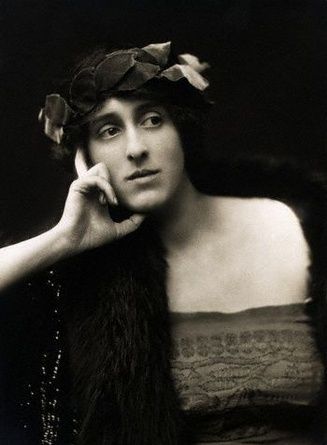
Vita Sackville-West
Vita fell in love with Rosamund Grosvenor (1888–1944), who was four years her senior.[b] In her journal, Vita wrote "Oh, I dare say I realized vaguely that I had no business to sleep with Rosamund, and I should certainly never have allowed anyone to find it out," but she saw no real conflict.[13]:29–30 Lady Sackville, Vita's mother, invited Rosamund to visit the family at their villa in Monte Carlo (1910). Rosamund also stayed with Vita at Knole House, at Murray Scott's pied-à-terre on the Rue Laffitte in Paris, and at Sluie, Scott's shooting lodge in the Scottish Highlands, near Banchory. Their secret relationship ended in 1913 when Vita married.[11][12]
Vita was more deeply involved with Violet Keppel, daughter of the Hon. George Keppel and his wife, Alice Keppel. The sexual relationship began when they were both in their teens and strongly influenced them for years. Both later married and became writers.[14]:148
Both Sackville-West and her husband had same-sex relationships before and during their marriage, as did some of the Bloomsbury Group of writers and artists, with whom they had connections.[16][17]:127 Sackville-West saw herself as psychologically divided into two: one side of her personality was more feminine, soft, submissive and attracted to men while the other side was more masculine, hard, aggressive and attracted to women.[17]
Sackville-West continued to receive devoted letters from her lover Violet Keppel. She was deeply upset to read of Keppel's engagement.[15]:131 Her response was to travel to Paris to see Keppel and persuade her to honour their commitment. Keppel, depressed and suicidal, did eventually marry her fiancée Major Trefusis, under pressure from her mother, though Keppel made it clear that she did not love her husband.[20]:62 Sackville-West called the marriage her own greatest failure.[20]:65
Sackville-West and Keppel disappeared together several times from 1918 on, mostly to France. One day in 1918 Vita writes that she experienced a radical 'liberation', where her male aspect was unexpectedly freed.[21] She writes: "I went into wild spirits; I ran, I shouted, I jumped, I climbed, I vaulted over gates, I felt like a schoolboy let out on a holiday... that wild irresponsible day".[21]
The mothers of both women joined forces to sabotage the relationship and force their daughters back to their husbands.[20] But they were unsuccessful. Vita often dressed as a man, styled as Keppel's husband. The two women made a bond to remain faithful to one another, pledging that neither would engage in sexual relations with their husband. [d]
Keppel continued to pursue her lover to great lengths, until Sackville-West's affairs with other women finally took their toll. In November 1919, while staying at Monte Carlo, Sackville-West wrote that she felt very low, entertaining thoughts of suicide, believing that Nicolson would be better off without her.[17] In 1920 the lovers ran off again to France together and their husbands chased after them in a small two-seater aeroplane.[21] Sackville-West heard allegations that Keppel and her husband Trefusis had been involved sexually, and she broke off the relationship as the lesbian oath of fidelity had been broken.[17] Despite the rift, the two women stayed devoted to one another.
Her relationship with the prominent writer Virginia Woolf commenced in 1925 and ended in 1935, reaching its height between 1925-28.[24]:195–214 The American scholar Louise DeSalvo wrote that the ten years between 1925-35 were the artistic peak of both women's careers as the two had a positive influence on one another: "neither had ever written so much so well, and neither would ever again reach this peak of accomplishment".[24]:195–214[e]
In December 1922 Sackville-West first met Virginia Woolf at a dinner party in London.[24]:197 Though Sackville-West came from an aristocratic family that was far richer than Woolf's middle class background, the women bonded over their confined childhoods and emotionally absent parents.[24]:198 Woolf knew about Sackville-West's relationship with Keppel and was impressed by the free spirit at play.[25][f][g]
The two grew close and Woolf disclosed how, as a child, she had been abused by her step-brother. [i] It was largely due to Sackville-West's support that Woolf began to heal the damage, allowing her for the first time to have a satisfying erotic relationship. [j] Woolf purchased a mirror during a trip to France with her lover, saying she felt she could look in a mirror for the first time in her life.
There were, however, tensions in the relationship. Woolf was often bothered by what she viewed as Sackville-West's promiscuity, charging that the great need for sex led her to take up with anyone who struck her fancy.[24]:213 In A Room Of One's Own (1929), Woolf attacks patriarchal inheritance laws, which was meant to be an implicit criticism of Sackville-West, who never questioned the leading social and political position of the aristocracy to which she belonged. She felt that Sackville-West was unable to critique the system she was both a part of and, to a certain extent, a victim of.[24]:209–210
In 1927 Sackville-West had an affair with Mary Garman, a member of the Bloomsbury Group and between 1929 and 1931 with Hilda Matheson, head of the BBC Talks Department.[27] In 1931, Sackville-West was in a ménage à trois with journalist Evelyn Irons and Irons's lover, Olive Rinder.
from wikipedia.
0 notes
Text
Anne Lister
Anne Lister (1791–1840) was a well-off Yorkshire landowner, diarist, mountaineer and traveller. Throughout her life she kept diaries which chronicled the details of her daily life, including her lesbian relationships, her financial concerns, her industrial activities and her work improving Shibden Hall.[1] Her diaries contain more than 4,000,000 words and about a sixth of them—those concerning the intimate details of her romantic and sexual relationships—were written in code.[1] The code, derived from a combination of algebra and Ancient Greek, was deciphered in the 1980s.[2][3] Lister is often called "the first modern lesbian" for her clear self-knowledge and openly lesbian lifestyle.[4] Called "Fred" by her lover and "Gentleman Jack" by Halifax residents, she suffered from harassment for her sexuality, and recognised her similarity to the Ladies of Llangollen, whom she visited.[5]

On her visits to her aunt Anne and uncle James at Shibden Hall, the Misses Mellin gave her lessons. In 1804 Anne Lister was sent to the Manor House School in York (in the King's Manor buildings), where Anne would meet her first love, Eliza Raine (1791–1869). Eliza and her sister Jane were the very rich daughters of an East India Company surgeon in Madras, brought to Yorkshire after his death. Anne and Eliza met and shared a bedroom aged 13 at boarding school, but Anne was asked to leave after two years. She rejoined the school after Eliza had left. Eliza expected to live with Anne as an adult, but Anne began affairs with Isabella Norcliffe and Mariana Belcombe, day-pupils at the school. In despair and frustration Eliza became a patient at Clifton Asylum, run by Mariana's father Dr Belcombe.[7][8] While being educated at home Lister developed an interest in classical literature. In a surviving letter to her aunt from 3 February 1803, a young Lister explains "My library is my greatest pleasure... The Grecian History had please me much.[9]
Lister is described as having a "masculine appearance"; one of her lovers, Marianna Lawton (née Belcombe), was initially ashamed to be seen in public with her because her appearance was commented on.[12] She dressed entirely in black[5] and took part in many activities that were not perceived as the norm for gentlewomen, such as opening and owning a colliery[10] She was referred to as "Gentleman Jack" in some quarters.[13]
Lawton and Lister were lovers for several years, including a period during which Lawton was married and had her husband's permission.[12]
Lister's subsequent affair with a wealthy heiress, Ann Walker, whom she met in 1832, was a story of local repute. The women took communion together on Easter Sunday 1834 in Holy Trinity Church, Goodramgate, York, which in their view married them. The church, recognised by a blue plaque, has been described as "an icon for what is interpreted as the site of the first lesbian marriage to be held in Britain."[14] The couple lived together at Shibden Hall until Lister's death in 1840. Walker's fortune was used to improve Shibden Hall and the property's waterfall and lake.[15] Lister renovated Shibden Hall quite significantly to her own design.[10] In 1838 she added a Gothic tower to the main house, to serve as her private library. She also had a tunnel dug under the building which allowed the staff to move about without disturbing her.[15] In 1830 while travelling in France, Lister was the first woman to ascend Monte Perdido in the Aragonese Pyrenees.[16] In 1838, she came back to the Pyrenees with Walker and completed the first "official" ascent of the Vignemale (3,298 metres (10,820 ft)).[17][18] In France she was known as Ann Lister or Lady Lister only for this accomplishment.
from wikipedia.
0 notes
Text
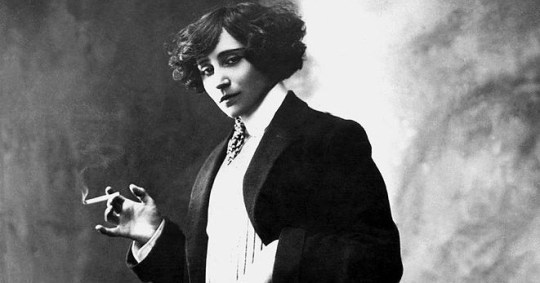
Colette
During these years she embarked on a series of relationships with other women, notably with Mathilde de Morny, Marquise de Belbeuf ("Missy"), with whom she sometimes shared the stage. On January 3, 1907, an onstage kiss between Missy and Colette in a pantomime entitled Rêve d'Égypte caused a near-riot, and as a result they were no longer able to live together openly, although their relationship continued for another five years.[9][10][11]
Mathilde de Morny (26 May 1863 - 29 June 1944) was a French noblewoman and artist. Her extravagant conduct made her a celebrity of the Belle Époque and despite her 1881 marriage to the known homosexual Jacques Godart, 6th Marquis de Belbeuf (1850 – 1906) – whom she divorced in 1903 – she was open that her sexual preference was for women. Though lesbian love was then fashionable, she was still attacked for this, especially due to her very masculine dress and attitude. At this time a woman wearing trousers could still scandalise even if she had been legally authorised to do so, as in the case of Rosa Bonheur (who sought police permission to wear trousers to make it easier for her to paint in the countryside). Mathilde wore a full three-piece suit (then forbidden to women), wore her hair short, and smoked a cigar.
Thanks to her personality and fortune, Mathilde de Morny became a lover of several women in Paris, including Liane de Pougy and Colette. From summer 1906 onwards she and Colette stayed together in the 'Belle Plage' villa in Le Crotoy, where Colette wrote the les Vrilles de la vigne and la Vagabonde which would be adapted for the screen by Musidora. On 3 January 1907 Mathilde and Colette put on a pantomime entitled Rêve d'Égypte ('Dream of Egypt') at the Moulin Rouge, in which Mathilde caused a scandal by playing an Egyptologist during a simulated lesbian love scene - a kiss between them almost caused a riot and the production was stopped by the prefect of police Louis Lépine. From then on they could no longer live together openly, though the relationship lasted until 1912.
from wikipedia.
0 notes
Photo

Chavela Vargas
Speculation aside, Vargas made no qualms about her sexuality. Even as a young woman in the conservative 1950s, she was well known around bars as a womanizer and heavy drinker, rarely without a cigar in hand. Vargas’s androgynous garb and public relationships with women further challenged the strict moral code of Mexico at the time, but she officially came out as a lesbian at the age of 81 in 2000 in an autobiography, Y si quieres saber de mi pasado (If You Want to Know About My Past). In an interview with EL PAIS, Vargas states, “I’m proud to carry this stigma and call myself a lesbian. I don’t boast about it or broadcast it, but I don’t deny it.”
from wikipedia and an article on pride.
0 notes
Photo

Tove Jansson
During her later studies, Jansson met her future partner Tuulikki Pietilä.[7] The two women collaborated on many works and projects, including a model of the Moominhouse, in collaboration with Pentti Eistola. This is now exhibited at the Moomin museum in Tampere.
Although she had a studio in Helsinki, Jansson lived many summers on a small island called Klovharu, one of the Pellinge Islands near the town of Borgå. Jansson's and Pietilä's travels and summers spent together on the Klovharu island in Pellinki have been captured on several hours of film, shot by Pietilä. Several documentaries have been made of this footage, the latest being Haru, yksinäinen saari (Haru, the lonely island) (1998) and Tove ja Tooti Euroopassa (Tove and Tooti in Europe) (2004).
Jansson's and Pietilä's travels and summers spent together on the Klovharu island in Pellinki have been captured on several hours of film, shot by Pietilä. Several documentaries have been made of this footage, the latest being Haru, yksinäinen saari (Haru, the lonely island) (1998) and Tove ja Tooti Euroopassa (Tove and Tooti in Europe) (2004).
from wikipedia.
0 notes
Text
Gertrude Stein and Alice B Toklas
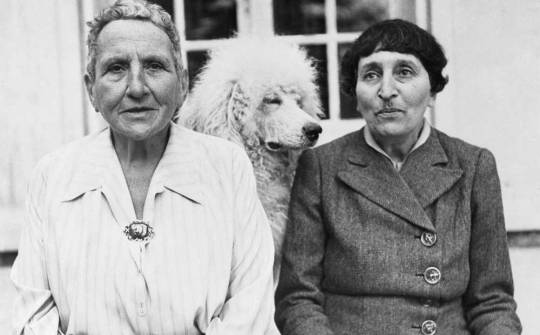
Stein met her life partner Alice B. Toklas[77] on September 8, 1907, on Toklas's first day in Paris, at Sarah and Michael Stein's apartment.[78] On meeting Stein, Toklas wrote:
She was a golden brown presence, burned by the Tuscan sun and with a golden glint in her warm brown hair. She was dressed in a warm brown corduroy suit. She wore a large round coral brooch and when she talked, very little, or laughed, a good deal, I thought her voice came from this brooch. It was unlike anyone else's voice—deep, full, velvety, like a great contralto's, like two voices.[79][80]
Soon thereafter, Stein introduced Toklas to Pablo Picasso at his studio, where he was at work on Les Demoiselles d'Avignon.
In 1908, they summered in Fiesole, Italy, Toklas staying with Harriet Lane Levy, the companion of her trip from the United States, and her housemate until Alice moved in with Stein and Leo in 1910. That summer, Stein stayed with Michael and Sarah Stein, their son Allan, and Leo in a nearby villa. Gertrude and Alice's summer of 1908 is memorialized in images of the two of them in Venice, at the piazza in front of Saint Mark's.[63]
Toklas arrived in 1907 with Harriet Levy, with Toklas maintaining living arrangements with Levy until she moved to 27 Rue de Fleurus in 1910.
With money acquired from the sale of Stein's last Matisse Woman with a Hat [85] to her brother Michael, she and Toklas vacationed in Spain from May 1915 through the spring of 1916.[86] During their interlude in Majorca, Spain, Gertrude continued her correspondence with Mildred Aldrich who kept her apprised of the War's progression, and eventually inspired Gertrude and Alice to return to France to join the war effort.[87]
The relationships of Stein's acquaintances Mabel Haynes and Grace Lounsbury ended as Haynes started one with Mary Bookstaver (also known as May Bookstaver). Stein became enamored of Bookstaver but was unsuccessful in advancing their relationship. Bookstaver, Haynes, and Lounsbury all later married men.[55]
Stein began to accept and define her pseudo-masculinity through the ideas of Otto Weininger's Sex and Character (1906). Weininger, though Jewish by birth, considered Jewish men effeminate and women as incapable of selfhood and genius, except for female homosexuals who may approximate masculinity. As Stein equated genius with masculinity, her position as a female and an intellectual becomes difficult to synthesize and modern feminist interpretations of her work have been called into question.[90]
More positive affirmations of Stein's sexuality began with her relationship with Alice B. Toklas. Ernest Hemingway describes how Alice was Gertrude's "wife" in that Stein rarely addressed his (Hemingway's) wife, and he treated Alice the same, leaving the two "wives" to chat.[91]
Five months after the devastating 1906 San Francisco earthquake, Toklas left the city and moved to Paris. On September 8, 1907, the day after she arrived in Paris, she met Gertrude Stein. This marked the beginning of a relationship which lasted for nearly four decades, ending in 1946 with Stein's death.
Together they hosted a salon in the home they shared that attracted expatriate American writers, such as Ernest Hemingway, Paul Bowles, Thornton Wilder, and Sherwood Anderson; and avant-garde painters, including Picasso, Matisse, and Braque.
Acting as Stein's confidante, lover, cook, secretary, muse, editor, critic, and general organizer, Toklas remained a background figure, chiefly living in the shadow of Stein, until the publication by Stein of Toklas' "memoirs" in 1933 under the teasing title The Autobiography of Alice B. Toklas. It became Stein's best-selling book.[3]
W. G. Rogers wrote in his memoir of the couple, published in 1946, that Toklas "was a little stooped, somewhat retiring and self-effacing. She doesn't sit in a chair, she hides in it; she doesn't look at you, but up at you; she is always standing just half a step outside the circle. She gives the appearance, in short, not of a drudge, but of a poor relation, someone invited to the wedding but not to the wedding feast."[4]James Merrill wrote that before meeting Toklas "one knew about the tiny stature, the sandals, the mustache, the eyes," but he had not anticipated "the enchantment of her speaking voice—like a viola at dusk."[5]
Toklas and Stein remained a couple until Stein's death in 1946.[6]
from wikipedia.
0 notes